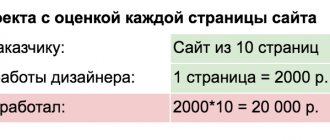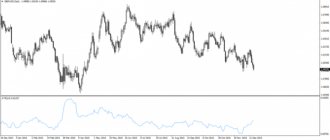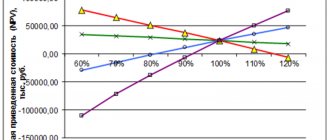Discount rate: the essence of the concept
The discount rate is necessary to discount cash flows. Choosing this bet is a very important and responsible matter. After all, if you look at the formulas, the magnitude of the given flows has a direct impact on the final result - the potential effectiveness of the project. And therefore, to make decisions regarding the implementation of investment activities.
The discount rate (comparison rate, rate of return, discount rate) is an interest rate that is used to bring the value of future cash flows to the current point in time.
There is another definition in which the discount rate is intended to help the investor compare the current business project with the least risky one (for example, with a deposit) or simply an alternative project.
The discount rate is the rate of return required by the investor, which should reflect the opportunity costs of investing capital in a particular project.
So, when discounting, since the rate is in the denominator, it reduces the present amount of cash flow. The higher the rate you choose, the lower the net present value you will get.
In this regard, the project's net present value (NPV, NPV) is less than just net income (NV, NPV). And the discounted payback period is longer than the undiscounted period.
Therefore, in order to obtain up-to-date and adequate calculations when drawing up a business plan, it is necessary to select the discount rate as accurately as possible.
How to do it? This is where methods for determining the project discount rate come to the rescue.
Formula of life: time + money
You can also turn to an example familiar to almost every person. We have some spare money that we can spend. But in order to increase our finances , we go to the bank to open an interest-bearing account there.
If you deposit 20,000 rubles. at 10% per annum, then after a calendar year, you will already have 22,000 rubles in your account.
In the formula this is calculated as: 20000*(1+10%).
The calculation for increasing (building up) the account , let’s take it over three years , will be slightly different: (20000*1.10)*1.10)*1.10= 26,620
And it looks like:
(1+R) N, where
R – interest rate in decimal,
N is the billing period.
The influence of the discount rate on the efficiency indicators of an investment project
Let's look at an example of how different rates of return affect the discount rate.
| Bet size | 1 year | 2 year | 3 year |
| discount rate - 5% | 0,952 | 0,907 | 0,864 |
| discount rate - 10% | 0,909 | 0,826 | 0,751 |
| discount rate - 20% | 0,833 | 0,694 | 0,579 |
As can be seen from the table, the higher the discount rate, the lower the discount factor.
This means that, for example, after 3 years at a rate of 5%, cash flows will depreciate and will be approximately 86.4% of the current value. Their purchasing power will decrease by 13.6%. If a discount rate of 20% is used in the calculations, then purchasing power will be reduced by 42.1%. That is why it is extremely important to choose the right rate of return for investment analysis.
Let us consider on the graph the influence of the rate on the efficiency indicators of the investment project.
The investment project involves a one-time investment of 1 million rubles. The calculation horizon is 5 years. Cash flows for the years of project implementation were respectively: 200 thousand rubles, 300 thousand rubles, 400 thousand rubles, 500 thousand rubles and 500 thousand rubles. It is necessary to calculate the net present value at different rates over the years: 5%, 10% and 20%.
Cash flows of an investment project at different discount rates
Thus, it is clear that the more accurately the current cash flow discount rate is determined, the more accurate the calculation result we obtain.
Examples of calculating cash flows using a discount factor
Let's look at an example of a calculation. A businessman invests 800 thousand rubles in a new six-year project. According to the business plan presented by the initiator, in 6 years he will be able to receive 1.5 million rubles in a one-time payment. A discount rate of 12% was determined in a cumulative manner, while the percentage of the discount rate is recorded when calculating as a fraction of one (0.12). Now, using the standard formula, you can calculate the value of the factor:
Kd = 1 / (1 + 0,12) 6
Kd = 1 / 1,9738
Kd = 0,5066
We obtained a reduction factor of 0.5066. After this, the discounting formula calculates the value of the present cash flow:
PV = FV * 1/(1+R)n.
PV = 1500000 * 0.5066
PV = 759900
From the obtained result we can draw a disappointing conclusion for the investor that under such starting conditions he should not expect not only profit, but even a simple return on the invested money. Therefore, such a proposal should be rejected or it should be proposed to change the basic conditions of the project, if this is acceptable (shorten the implementation period or reduce the discount rate).
Let's assume that the discount rate in our example is reduced to 10%. In this case, the coefficient value will be 0.5645, and the reduced cash flow will increase to 846,750 rubles, which will make the project profitable. A similar situation arises if the implementation period is reduced to 5 years at a rate of 12%: the factor will be 0.5674, and the flow will be 851,100 rubles.
It should be noted that in order to determine the discount factor, there is no need to dive into mathematical formulas every time. To simplify this task, a table of discounting factors has been developed and is widely used in practice. It is built according to a standard scheme, like the Pythagorean or Bradis tables, that is, interest rates are indicated on one axis, and time periods are indicated on the other. To find the desired indicator, it is enough to find the cell where they intersect; it contains the value of the coefficient accurate to ten thousandths (up to the fourth decimal place).
All coefficient values given above are taken from this table. This significantly speeds up calculations and makes it possible to calculate alternative scenarios without unnecessary effort.
We considered a problem that involved payment of money in one payment after the end of the project. In practice, situations are much more common when payments are made annually. Then, for the calculations to be correct, it is necessary to find the reduction coefficient for each year separately. For example, our investor will receive his one and a half million over 6 years of the initiative’s life cycle at a discount rate of 10% in equal parts of 250 thousand rubles per year (i.e. as an annuity):
Using the annual calculation formula, you can find the coefficients separately for each period and then sum them up:
| CF1 | CF2 | CFN | |||
| NPV = | —— | + | —— | +…+ | —— |
| (1+R) | (1+R)2 | (1+R)6 |
PV = 227272 + 206611 + 187828 + 170765 + 155279 + 141083 = 1088838 rubles.
If you use the table of annuity payment coefficients, then it will be enough to multiply the average annual payment by the factor indicated in the desired cell of the table (in this case it is 4.3553).
PV = 250000 * 4.3553 = 1088825 rubles
Thus, we see that the indicator found using the formula is almost similar to the value determined using tables (1088838 versus 1088825).
The dangers of choosing the wrong rate of return
The fact that the discount rate affects the results of calculations has already been considered. But why is it so dangerous to choose the wrong size?
The fact is that all business plan indicators are forecast. This means that the more accurate the forecast, the more accurate the project performance indicators obtained as a result of the calculations.
At the same time, the investor makes a decision on investing his capital based on indicators, for example, net present value and internal rate of return. And these indicators directly depend on the size of the profit margin.
This means that if the discount rate is underestimated relative to the real one, then the result of calculating the effectiveness of the investment project will be overestimated. Consequently, a situation may arise when, according to the business plan, the project is acceptable (NPV>0), but in fact it is unprofitable.
In addition, the case when the rate of return is overestimated is also potentially dangerous. Since in this case, projects that, as a result of calculation, received a negative NPV may be rejected. However, in fact, such projects, with the right rate, could be of interest to the investor and would generate income for him.
Therefore, it is very important to choose the right discount rate. Since both overestimated and underestimated values negatively affect the decision-making process regarding the effectiveness of the investment project.
Assessment of international companies using the cumulative construction method
If the company is compared on the global market, then it is necessary to calculate the value of country risk. Country risk – reflects the solvency of the national economy as a whole. One of the easiest ways to assess it is to use international country credit ratings (S&P, Moody's or Fitch). The figure below shows country risk values for international credit ratings; data was obtained from the official Moody's website ↓.
| Country rating | Country risk, % | Explanation |
| AAA | 0,2 | Upper investment grade |
| AA | 0.75 | |
| A | 1.25 | |
| BBB+ | 1.5 | Lower investment grade |
| BBB | 2 | |
| BBB- | 2.5 | |
| BB+ | 3 | The level of risk of insolvency is high |
| BB | 3.5 | |
| BB- | 4 | |
| IN | 5 |
Currently, the credit rating is Moody's → Ba1, S&P → BB+, which shows high country risks for international investors, and which must be taken into account when calculating the discount rate. Thus, for the enterprise PJSC KAMAZ, the discount rate, taking into account country risk, will be 26.38%.
Summary
The method of cumulative construction of the discount rate is used to calculate the discount rate and capitalization ratio as a derivative. The use of the method takes into account the company’s difficult-to-formalize risks, thereby increasing the accuracy of assessing the rate of return. Despite this, the use of expert methods introduces a degree of subjectivity into the assessment. A solution to this is to use a panel of experts, where their scores can be averaged or a score weight assigned to each participant.
| Business valuation | Financial analysis according to IFRS | Financial analysis according to RAS |
| Calculation of NPV, IRR in Excel | Valuation of stocks and bonds |
What influences the discount rate?
As already mentioned, the discount rate shows how much the value of money received in the future will differ from the current value. There are many factors influencing this process. One of the most frequently cited factors is inflation. However, in fact there are many more factors.
These factors include the likelihood of any force majeure situation occurring and, for example, the cost of capital used to finance the project.
Discount factor calculation
Direct reduction of cash flow is understood as the product of its value and the discount factor, to determine which the following formula is used:
Where:
- tm – calculation end period;
- E – discount rate (indicated in fractions of a unit).
This formula can be adopted in the case where E remains unchanged throughout the entire duration of the initiative.
However, for a more correct calculation of the indicator, especially when implementing long-term projects (more than one year), a variable discount rate is used. It is relevant in such cases when:
- the capital structure changes over time;
- the magnitude of risks is dynamic and cannot be recorded accurately enough;
- bank interest rates change frequently;
- there are noticeable exchange rate fluctuations (when production is tied to foreign markets), etc.
In such cases, another, more complex formula is used, which takes into account fluctuations in the value of the discount rate:
Where:
- E0, …, Em denote discount rates at the 0th, …, m steps, respectively;
- D0,…, Dm – duration of the specified steps in annual or other terms.
For example, if the key rate of the Central Bank (and, accordingly, the refinancing rate) is reduced, the value of the discount rate will also decrease. If its indicator is based on the weighted average cost of capital (WACC), then when the dividend policy or capital structure changes, E will also fluctuate.
Methods for determining the discount rate
So how do you determine the discount rate? There are many ways to do this. Calculation formulas include different components of the discount rate.
Let's look at the most commonly used calculation methods.
Fischer formula
This method is called the Fisher effect. It relates the nominal interest rate to the real interest rate to the inflation rate.
,
r_m — real interest rate; i is the inflation rate.
When determining the minimum real yield (real interest rate), you can take as a basis:
- refinancing rate;
- average rate on deposits of Sberbank of the Russian Federation;
- the rate of return on government securities (OFZ - federal loan bonds).
The current inflation rate can be found on the website of the Central Bank of the Russian Federation.
Thus, since the real interest rate is used when calculating the rate, NPV=0 does not mean that the project is unprofitable. It follows from this that this investment project will bring income that the investor could receive by placing funds, for example, on a deposit.
Abbreviated Fischer formula
After some transformations, Fisher's formula can be simplified to the following form:
Cumulative construction model
The cumulative construction model, unlike the Fisher model, also takes into account all types of risk.
In general, the discount rate will be equal to:
Discount rate = Risk-free rate + inflation + risk i
Or this formula can be transformed as follows:
,
where R is the total risk for the project.
Thus, this formula is essentially a Fisher formula taking into account risk.
Therefore, it can be written in another form:
.
Read on to learn how to determine the percentage of risk for a project.
Weighted average cost of capital (WACC)
Another method for determining the rate of return (discount rate) is a method based on calculating the average cost of capital used to finance the project.
Due to the fact that investment resources can be different, for example, own, borrowed or attracted. And the fee for each type can be completely different. For example, if a company raised funds by issuing a bond issue, this is the size of the coupon. If you took a loan from a bank, this is the interest on the loan, etc. There is a need to determine the weighted average cost of capital (WACC) .
The weighted average cost of capital (WACC, Weighted Average Cost of Capital) is used to assess the company's return on capital, as well as the effectiveness of the investment project.
where Pi is the cost of the i-th source of financing, di is the share of the i-th source of financing in the total amount of financing, n is the number of attracted sources.
where Re is the rate of return on equity capital, E is the market value of equity capital, D is the market value of borrowed capital, K is the volume of short-term accounts payable, B is the balance sheet currency, Rd is the cost of borrowed capital, t is the rate income tax, Rk – cost of using accounts payable.
wherein
Principles for determining indicators included in the WACC formula:
- the rate of return on equity ( Re ) can be calculated as return on equity;
- The market value of equity ( E ) can be defined as the product of the company's total number of common shares and the price per share.
- the market value of debt capital ( D ) is often determined from financial statements as the amount of company borrowings;
- volume of short-term accounts payable ( K ). This takes into account debt to suppliers and contractors, to the organization’s personnel, extra-budgetary funds, taxes and fees, and debt to other creditors.
- the rate of return on borrowed capital or, as it is also called, the cost of attracting borrowed capital ( Rd ), can be equated, for example, to interest on bank loans. In this case, the cost of borrowed capital is adjusted taking into account the income tax rate ( t ). The meaning of the adjustment is that interest on servicing loans and borrowings is charged to the cost of production, reducing the tax base for income tax.
- The cost of using short-term accounts payable ( Rk ) is most often zero. However, in the case of payment of a trade loan, payment of penalties and fines for late payment, it is necessary to record these payments for the reporting period in relation to the average amount of accounts payable for the reporting period.
Example of WASS calculation
Let's look at the example of the weighted average cost of capital attracted to an investment project. If an investment project is financed 60% from equity capital, and, accordingly, 40% from borrowed capital. The cost of attracting equity capital is 8%, borrowed capital is 12%. Income tax - 20%.
Therefore, the weighted average cost of capital of this business project (WACC) is 8.64%.
Model CAMP
CAPM (Capital Asset Pricing Model ) is a capital asset pricing model.
The CAMP model, which is part of modern portfolio theory, was originally developed by G. Markowitz and was modified by his student W. Sharp back in the 70s of the 20th century. The main purpose of this model is to estimate the future return on shares/capital of companies.
The CAPM model reflects future returns as the return on a risk-free asset and a risk premium. As a result, if the expected return on a stock is lower than the required return, investors will refuse to invest in this asset.
This model also takes into account market risk. Therefore, the formula for calculating the discount rate using the CAPM model can be presented as follows:
,
where ri is the expected return on the stock (discount rate);
rf – return on a risk-free asset (for example, deposits or government bonds);
rm is the market return, which can be taken as the average return on the index (MICEX, RTS - for Russia, S&P500 - for the USA);
Bi – beta coefficient. Reflects the riskiness of the investment in relation to the market, and shows the sensitivity of changes in stock returns to changes in market returns.
Markowitz and his followers believed that, in general, the deviation of the return of each specific stock in the long term tends to the average return of the market. However, in the short term, some stocks are more volatile than others.
It was to reflect the degree of volatility of a particular financial instrument that the “beta coefficient” .
Beta coefficient criteria:
- β = 1 – the profitability of such a security corresponds to the profitability of the market (stock index);
- β > 1 – the profitability (as well as volatility) of such securities is very sensitive to market changes. Investing in such assets is risky;
- 0 < β < 1 – such assets have less risk, but are also less profitable in the future;
- β = 0 – there is no connection between the security and the market (index) as a whole;
- β < 0 – the yield of securities is inversely proportional to the profitability of the market.
Currently, it is not necessary to independently calculate this coefficient, since from 2021 it is calculated by the Moscow Exchange.
An example of calculating a discount rate based on the CAMP model
Calculate the discount rate based on the CAMP method, if the current refinancing rate of the Central Bank is 6%, the average market income rate is 12%, and the beta coefficient is 1.71.
.
Modified CAPM model
The modified CAPM model is based on the simple CAMP model, but also takes into account the potential risks of a business project.
Calculation of the discount rate based on the modified CAPM model:
,
R is the risk premium, which includes all types of risks that affect profitability.
Calculation of the discount rate based on profitability indicators
Another option for determining the rate of return may be the option when the rate is equated to some performance indicator.
For example, return on equity (ROE, Return On Equity) or, for example, return on assets (ROA, Return On Assets), as well as average industry profitability, can be used as a basic indicator.
This approach is most often used to evaluate new investment projects within an existing business. In this case, the rate of return is taken, for example, the profitability of the current business.
In this case, NPV=0 will mean that the new project has the same profitability as the existing one. If the net present value is less than zero, this does not mean that the project is unprofitable, just that its profitability is lower than the efficiency of an existing project.
Expert review
Another method for determining the discount rate is based on expert assessment. That is, in this case, the value of the rate of return is determined by selected experts.
This method is often very inaccurate. Here, the adequacy of the rate largely depends on the professionalism of the expert.
Calculation of risk-free interest rate
The following methods can be distinguished for calculating the risk-free interest rate:
- Profitability assessment based on the yield of government securities (GKOs, OFZs). Since these securities are issued by the Ministry of Finance, they have the maximum credit rating of reliability. The yield can be viewed on the official website of the Central Bank of the Russian Federation. It should be noted that none of the financial instruments is absolutely reliable.
- Estimation of risk-free yield based on the yield on the most reliable bank deposits. One of the most reliable banks is Sberbank (Moody's international credit rating: Baa3 and Fitch BBB-). The rating has moderate credit risks and is considered for long-term investments. The yield on Sberbank deposits is currently 5.59%.
For more information about methods for calculating the risk-free interest rate, read the article: → “5 ways to calculate the risk-free interest rate.”
Approaches to calculating risk premium
Many methods for determining the discount rate include the likelihood of a shortfall in planned cash flows as a result of a force majeure situation.
The size of the risk premium is influenced by many factors.
Among them are:
- type of investment;
- the size of the company and its place in the market;
- the solvency of the organization and the degree of liquidity of its assets;
- industry affiliation and risks inherent in this industry;
- inflation;
- currency fluctuations;
- and much more.
However, there are standard approaches for determining risk. These approaches link the amount of risk and the type of investment.
- the approach set out in the “Regulations on assessing the effectiveness of investment projects when placing centralized investment resources of the development budget of the Russian Federation on a competitive basis.”
- technique .
The magnitude of the risk according to the methodology set out in the “Regulations on assessing the effectiveness of investment projects when placing centralized investment resources of the development budget of the Russian Federation on a competitive basis”
| Magnitude of risk | Sample Project | Risk premium, % |
| short | investments during intensification based on mastered technology | 3–5 |
| average | increasing sales volume of existing products | 8–10 |
| high | production and marketing of a new product | 13–15 |
| very tall | investment in research and innovation | 18–20 |
Amount of risk according to the methodology
| Characteristics of the source of project risk | Risk premium, % | WACC + risk premium, % |
| project supporting production | 0 | 18 |
| expansion of production | 3 | 21 |
| entering new markets | 6 | 24 |
| related business areas (new product) | 9 | 27 |
| new industries | 12 | 30 |
Definition of discount and its norm
Discounting is an economic tool convenient for making decisions: is it worth investing in a specific business project? This is a method that helps to assess the value of invested capital at a given moment. The idea is that the real money we have at our disposal now is worth more than exactly the same amount in the future. For example, 20 thousand rubles in your pocket today is always more expensive than the same 20 thousand, but in 3 years. There are several reasons for this:
annual inflation eats up savings, so in a few years you can buy fewer goods and services with 20 thousand rubles- cash can already bring profit if, for example, you put it in a bank at interest
- force majeure circumstances, changes in market conditions can lead to a lack of profitability in principle
The discount rate is the profit that can be previously estimated from investing in a future project. The best offer is determined by calculations.
Setting the norm
To make an investment decision, it is important to establish a discount rate that determines future income. The deposit rate is a simple example of setting a rate.
If the profitability is determined, for example, at 12%, and calculations show that the project will bring less profit, then the investor may decide to refuse to participate in the project. However, the bank rate is not always accepted as the norm. The yield of government bonds, the cost of capital, and the inflation rate can be taken as a basis.
The discount rate is influenced by internal and external factors:
- price increase rate
- change in interest on deposits and loans in banks
- market prices for company products
- economic indicators of the enterprise
- inconsistency of financial transactions within the company (delays between payment for raw materials and sales of products)
- changes in the economic environment (loan rates, taxes, wages)
These factors complicate the calculation of the discount rate. Economists advise when determining it to rely on:
- data on inflation dynamics
- economic indicators of the company
- tax rates
Benefits of Absolute Analysis
- A company's valuation is based on real things—cash flows. It can also take into account their growth rates and risks.
- Absolute analysis provides an assessment in the form of specific figures that can be compared with the market price. If the market price is lower than the valuation obtained, then the company is trading below its fair value and its acquisition is profitable.
- This method is based on the fact that the market as a whole can sometimes be mistaken regarding the fair valuation of shares. This gives it an advantage over relative valuation, which is based on the fact that the market as a whole values all stocks fairly, with only occasional errors. Therefore, using absolute analysis, you can avoid cases where a company looks undervalued compared to its peers, but the entire sector is overvalued relative to the market.
Adjusting the discount rate
In practice, the discount rate must be adjusted taking into account investment risks. To adjust, a risk percentage is added to the norm and only after that the investment efficiency is calculated. Moreover, the greater the investment risks, the greater the premium will be, the amount of which is calculated individually in each case.
Thus, for the expansion of a successful company, a risk premium can be set at 9%, for the implementation of a new project - 13%, for introducing new products to the market that require a long production and sales cycle - 25%.
If the company's initial capital was valued at 7%, then the discount rate for the above cases will be equal to 16%, 20%, 27%, respectively.
Thus, the discount rate, the formula of which is discussed in this article, is an effective economic tool for assessing the profitability of investments. Discounting helps determine profit both in simple cases, for example, in deposits, and for complex investment projects with many components (fixed and borrowed capital, tax rate, premium risks).
Top
Write your question in the form below
Internal discount rate
This is the discount rate at which, after a certain period of time, the project will return the funds invested in it. However, the profit will be zero. This indicator is designated IRR. The formula for calculating this parameter is as follows:
- t – estimated time period
- IC – amount of invested funds
- CFT – enterprise financial flows
If the IRR exceeds the costs, then the project can be considered promising; if it is lower, it is better to abandon it.
Enlarged calculation method
When determining the profitability of an investment, the discount rate is often calculated as the average between the cost of capital and borrowed funds:
Where:
- E – estimated value of the enterprise’s capital on the market
- D – estimated price of borrowed funds
- Re – rate of return
- tc – income tax as a percentage
In practical activities:
- E = sum of all company shares × price of one share
- D = cost of all company borrowings
The total cost of capital of a particular enterprise is estimated using the CAPM model.
The return on equity is determined by the formula: Here Rf is the risk-free rate of return.
Let's consider an example of determining discounting using an aggregated calculation method. For example, a company plans to take out a loan of $10,000 at 15%, while its own investment is $5,000. An alternative to the project is placing money on deposit in a bank at 8%. The income tax on project implementation will be 18%. Based on these data, using the formula, we get the result:
WACC = 10000 / (10000 + 5000) x 15% + 50000 / (10000 + 5000) x 8% x (1 – 18%) = 10% + 5% x 0.82 = 14%
Thus, the project can be considered profitable.
Types of discount rates on video:











